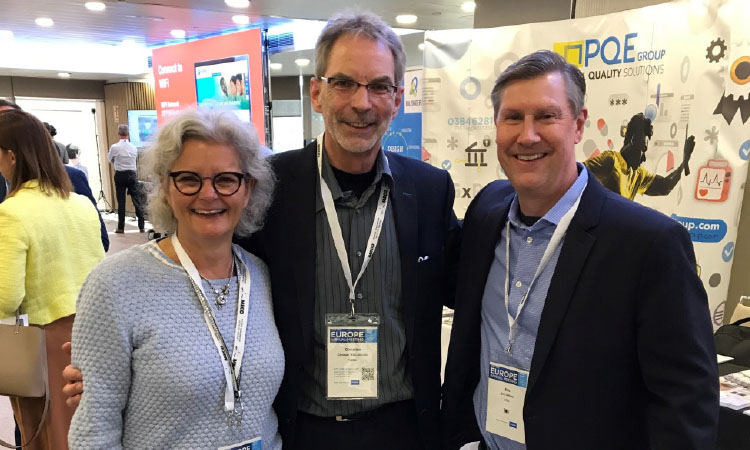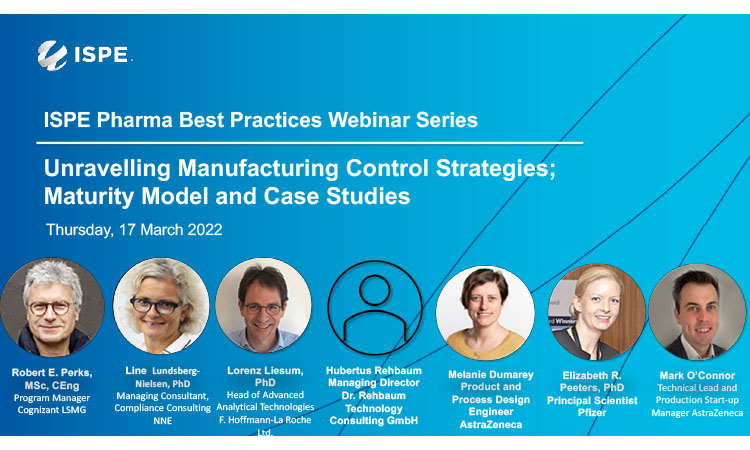Tell Us about the Webinar the Communities of Practice Presented in March 2022
We were originally scheduled to present this research at the 2021 ISPE Annual Meeting & Expo, but most of the presenters live in Europe and were not able to travel to the conference. To share our work with the community, we decided to convert this into a webinar instead (see Figure 2), “Unravelling Manufacturing Control Strategies: Maturity Model and Case Studies.”
Control strategies are becoming more important, and companies must have many different strategies in place to secure robust manufacturing, including monitoring and review of manufacturing data to ensure product quality throughout the product’s life cycle. Our Communities of Practice examined the different impact areas and strategy implementation, how they are related, and determined the benefits of different strategies in terms of speed, efficiency, and agility. We then asked the question, “What are the capabilities required for applying these control strategies?”
In the webinar, we presented a life-cycle control strategy maturity model that can identify opportunities to improve new and existing product control strategies. The model links digital maturity and control strategy maturity to enable process robustness and product quality assurance in an efficient manner. The model includes different capabilities such as development approaches, digitalization, analytics including PAT, modeling, data analytics, control regimes, and release strategies.
Control strategy maturity has been discussed by different industries and organizations but never formulated in detail in the pharmaceutical industry. With this model, we have tried to bridge the different control strategy approaches and, in particular, link the FDA control pyramid, Pharma 4.0™ digital maturity, and the use of PAT and real-time release testing (RTRT).
What Do You Enjoy about Being a Volunteer with ISPE?
ISPE has been very important in developing me professionally. I have learned a lot from my ISPE connections, particularly when I’ve been able to work with colleagues from other pharmaceutical companies. When you can collaborate and discuss with others, you learn from them. Sharing knowledge is important because you cannot learn everything you need to be successful by yourself or just by reading articles or taking courses. When you are trying to solve a problem, it really helps to hear what others have done.
For example, through ISPE I met one of the PAT pioneers within a globally operating pharmaceutical company. At that time, I was working at a smaller pharmaceutical company, and I invited him to come and talk to our production and development senior management about what his company had achieved by applying PAT. This talk was an eye-opener and my senior management gave me the go-ahead to kick off a PAT program. I became responsible for implementing PAT and quality by design (QbD).
This connection through ISPE was an amplifier for my professional career. It is all about having a good network to work and share knowledge with, and I get that through ISPE.
One of the things I try to do is to support our emerging leaders in our Communities of Practice so they can get exposure by talking at conferences, writing, and presenting to expose them to members working in similar endeavors. I try to connect them with other people.
What Do You See as the Future of the Communities of Practice?
Right now, the Communities of Practice has strong momentum. One of the Communities of Practice Steering Committee members suggested we discuss PAT modeling and data analytics using Open Source software and new digitization efforts. We are hoping to kick off some town-hall-type meetings for the Communities of Practice members at large. We would love to see more robust conversations on our forum in ISPE Engage. We really encourage members to get involved, to ask their questions, and to propose content that they want us to focus on.
Learn More & Join
PE Magazine Wants Your P+E!
Tell us about your Chapter and Affiliate events and conferences, trainings and Women in Pharma® meetings, Emerging Leaders activities, and Communities of Practice and Special Interest Group work, and we’ll share it with all of ISPE in Pharmaceutical Engineering’s People+Events (P+E) section. Please submit articles and short items for ISPE Briefs to ssandler@ispe.org—ISPE Briefs can be up to 400 words, articles can be up to 1,000 words. Photos are welcome: at least 300 dpi or >1 MB.






